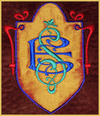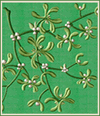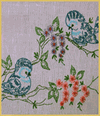Lace Technique - Step By Step Guide

Hope you will enjoy our standalone lace designs.
Please read through this small tutorial, because it will show you how to do gorgeous lace projects on embroidery machine.
Good luck!
1. Heavy duty water soluble backing
2. High quality polyester machine embroidery thread
Regular 40 wt thread is perfect. Just make sure you purchase a quality brand. With lace designs, using strong thread is especially important, because they have many stitches, and you would probably prefer to drink coffee or do something fun while your machine is working, instead of babysitting each design for half an hour. Also, thread breaks can cause the laces to unravel later.
3. Standalone lace designs
2. If you have new supplies (thread, stabilizer) - try them out first on one small test design, to see if everything is ok. Stitch it, wash away the water soluble and dry - just to see that your backing and thread are working well together. Only then continue with your main project.
Attention: It may seem to you that one layer of strong WSB is enough. Yet, many machines start breaking thread terribly, when only one layer on WSB is used. We've noticed that often an extra layer of water soluble just solves this problem. So avoid trying to save an extra layer, even if your WSB is very strong.
2. Embroider the design.
If your project requires more that one lace design to be stitched out - embroider each of them in separate hoop, and for each design pick up the smallest suitable hoop you can.
Make sure that the WSB can't move, even slightly. If your hoop is far from perfect, and holds fabric badly - consider purchasing a new hoop with special metal spins. This is quite a small expense, that can take your embroidery to a totally new level. Most machine dealers now carry those wonderful new hoops with spins. As a temporary solution, you can wrap a paper towel around one hoop frame, to add friction and prevent your backing from moving.
3. After you've stitched all lace pieces, cut away large edges of water soluble backing around each design, leaving about 1 inch from each side.
4. WHILE THE WSB STILL THERE, position all lace pieces on your future project the way you want them to be.
- If your project requires to sew the pieces of lace together, do this first. To secure all pieces together, use Temporary Adhesive Spray. When they hold, just stitch them together manually, or using a sewing machine. Then wash away the backing, lay flat on a towel and dry.
- In case you're creating a project with "lace border frame" around it (like placemat, for example), now place the lace frame on your fabric, draw around the inside contours using disappearing ink pen. Cut the excess fabric leaving a 1/4 inch for overlap, and trim fabric edges. Pin the lace to fabric, and sew them together using small straight stitch on your sewing machine, and invisible thread. Or, you may use the same thread color of your lace designs.
- For single lace designs that shouldn't be attached one to another, just secure each piece on it's place using Temporary Adhesive Spray or pins. Now, carefully stitch the laces to your project, either manually or using small straight stitch on your embroidery machine.
You may want to use invisible thread for this purpose, or the same thread color you've used for embroidering lace.
Wash away the water soluble in warm water. If you want the lace to be as soft as possible - you may even leave the item in warm water for half an hour or so, to make all water soluble substance to go away.
Dry your project carefully by laying it flat on a towel.
Please read through this small tutorial, because it will show you how to do gorgeous lace projects on embroidery machine.
Good luck!
General Suggestions
Make sure you have the following items at your disposal:1. Heavy duty water soluble backing
2. High quality polyester machine embroidery thread
Regular 40 wt thread is perfect. Just make sure you purchase a quality brand. With lace designs, using strong thread is especially important, because they have many stitches, and you would probably prefer to drink coffee or do something fun while your machine is working, instead of babysitting each design for half an hour. Also, thread breaks can cause the laces to unravel later.
3. Standalone lace designs
Warnings
1. NEVER resize lace designs. Most chances are that you'll ruin them completely. They are very sensitive to precision. While regular design may resize ok, a resized lace design will most probably fall apart after you wash away the water soluble backing.2. If you have new supplies (thread, stabilizer) - try them out first on one small test design, to see if everything is ok. Stitch it, wash away the water soluble and dry - just to see that your backing and thread are working well together. Only then continue with your main project.
Detailed Instruction
1. Hoop 2-3 layers of heavy duty water soluble backing (different brands require different number of layers).Attention: It may seem to you that one layer of strong WSB is enough. Yet, many machines start breaking thread terribly, when only one layer on WSB is used. We've noticed that often an extra layer of water soluble just solves this problem. So avoid trying to save an extra layer, even if your WSB is very strong.
2. Embroider the design.
If your project requires more that one lace design to be stitched out - embroider each of them in separate hoop, and for each design pick up the smallest suitable hoop you can.
Make sure that the WSB can't move, even slightly. If your hoop is far from perfect, and holds fabric badly - consider purchasing a new hoop with special metal spins. This is quite a small expense, that can take your embroidery to a totally new level. Most machine dealers now carry those wonderful new hoops with spins. As a temporary solution, you can wrap a paper towel around one hoop frame, to add friction and prevent your backing from moving.
3. After you've stitched all lace pieces, cut away large edges of water soluble backing around each design, leaving about 1 inch from each side.
4. WHILE THE WSB STILL THERE, position all lace pieces on your future project the way you want them to be.
- If your project requires to sew the pieces of lace together, do this first. To secure all pieces together, use Temporary Adhesive Spray. When they hold, just stitch them together manually, or using a sewing machine. Then wash away the backing, lay flat on a towel and dry.
- In case you're creating a project with "lace border frame" around it (like placemat, for example), now place the lace frame on your fabric, draw around the inside contours using disappearing ink pen. Cut the excess fabric leaving a 1/4 inch for overlap, and trim fabric edges. Pin the lace to fabric, and sew them together using small straight stitch on your sewing machine, and invisible thread. Or, you may use the same thread color of your lace designs.
- For single lace designs that shouldn't be attached one to another, just secure each piece on it's place using Temporary Adhesive Spray or pins. Now, carefully stitch the laces to your project, either manually or using small straight stitch on your embroidery machine.
You may want to use invisible thread for this purpose, or the same thread color you've used for embroidering lace.
Wash away the water soluble in warm water. If you want the lace to be as soft as possible - you may even leave the item in warm water for half an hour or so, to make all water soluble substance to go away.
Dry your project carefully by laying it flat on a towel.






